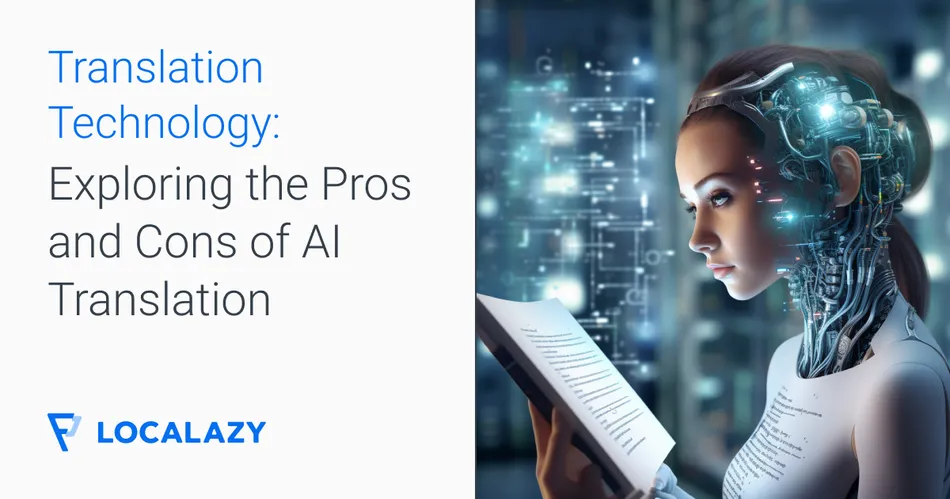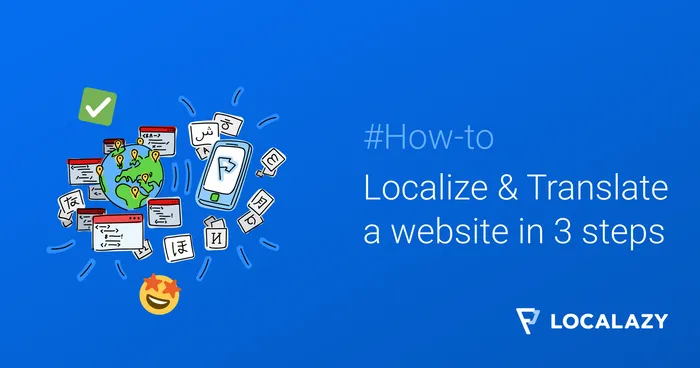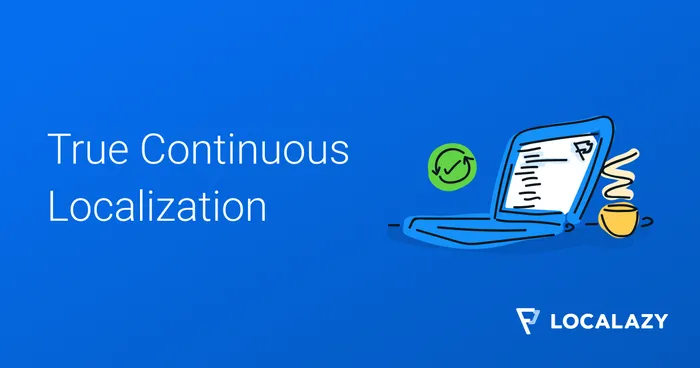Will the world need Localazy and human translators for our services? Or will AI-based tools take our ice cream, leaving us all crying like innocent children? 🤯
Slow down. We're about to break the myth of ChatGPT and its fellas. Our team of developers working hasn't flinched since the magician stepped on the scene.
That's because they know that behind every 🪄 magician, there are a few logical acts the audience doesn't see. And in this case, it's still merely ones and zeros working in the background.
However, since translation is a vast topic, we'll discuss the effectiveness of AI translations in the translation and localization of your assets. But for starters, let us first define what we mean by AI translation.
🤔 What is AI in translation? 🔗
Taking Artificial Intelligence to power your translation process is a strategically wise decision. But what does go under the hood of the AI translation tech?
The combination of machine learning algorithms and neural networks paired to output a suitable translation from one language to the other makes the translation process possible in an AI-based tech. AI models are trained on large amounts of multilingual data and are instructed to distinguish patterns and deliver matching translations.
With the pompous news on ChatGPT and other similar Large Language Models (LLM), you're probably wondering if AI is just a buzzword or a well-trained neural network capable of delivering smart outputs. Well, in the way it's portrayed now, as a substitute for human intelligence, it's definitely a buzzword.
The concept of Artificial Intelligence in tools like ChatGPT sounds a bit like a fantasy fiction term, and it doesn't correctly describe the tech behind it. For clarity, it's best to stick to the terms machine learning and neural network.
Despite AI models like ChatGPT being good at producing acceptable translations, we shouldn't forget that they lack a nuanced and culturally aware understanding of a human translator and can't yet operate in the context of the project with as much accuracy as humans do.

❌ Cons: When it's a bad idea to use AI translations 🔗
To pick where we left off, the translation output from an AI model is often blunt, too verbatim, and lacks emotion. If you think you'd be all good translating your website or app by using ChatGPT, you're better off using DeepL, which is a translation engine fueled by machine learning. AI translation comes with considerable downsides:
- Almost zero cultural context. Not considering cultural differences when translating text can lead to inappropriate and even offensive translations. AI translations are incapable of respecting cultural differences.
- Private data can fall into the hacker's hands. Data leaks are common in the internet age, and this risk becomes even more probable when you input all your private data into well-known AI tools like ChatGPT. Even big companies restrict employees from using ChatGPT due to data privacy concerns.
- Domain-specific translations require human expertise. When it comes to translating highly technical content in the domains of healthcare or law, AI translations lack the depth of knowledge which is gained only by experience.
- Unable to consider the linguistic context. Linguistic context is vital to accurately translate humor, puns, idioms, wordplay, irony, sarcasm, etc. AI translators are unable to understand these nuances of human language.
Tools such as ChatGPT are great for low-risk translations. We can't say even short translations because that would imply using it for microcopy localization is a good idea.
UX and UI writing requires close attention to detail and leaves no space for fluff, which is pretty common when using ChatGPT. The role of context in translation is crucial, and ChatGPT doesn't ingest enough context from the fed data when producing translations.
Learn more about digital product localization with Figma and Localazy
If you're considering using AI on personal projects or general blog content that doesn't contain much depth or importance, these downsides might appear insignificant. While you need to be careful when relying on it for large projects, there are definitely some positive aspects about it worth mentioning.
✅ Pros: When it's a good idea to use AI translations 🔗
AI might fail as a sole translator, but it is an efficient assistant to a skilled human translator. Human expertise and guidance can change the quality of the translations outputted by AI tools. Tools like ChatGPT might not produce a final version of the translation, but they're great at providing initial translations and even assisting the translator in recalling certain concepts and words. Some noticeable benefits here are:
- Lighting speed translations. AI translation tools surpass the average pace of a human translator by 1000x. This means you'll have more time to spend on editing, perfecting those translations, and meeting deadlines.
- AI translation costs are affordable. AI translation tools require a small investment compared to hiring a professional translator. Therefore, they're an ideal choice if you have a small budget for your project.
- Translations from multiple fields are supported. AI models have been trained on a massive corpus of knowledge, enabling them to translate content from various fields. Human translators are rarely experienced in more than one field.
- Accessible and flexible implementation. Using specific plug-ins and integrations, you can integrate AI-based tools like ChatGPT to translate content from multiple mediums and platforms without human intervention.
These are some of the positive aspects of integrating AI or machine translation into your localization workflow, but they certainly come with their own limitations, especially if you're using ChatGPT.

🤖 The limitations of ChatGPT 🔗
Why it won't resolve your translation needs at scale 🔗
The first obstacle stands in the fact that ChatGPT relies on pre-existing training data, and its knowledge is limited to what it has been trained on.
As a result, its translations may not always be as accurate or contextually nuanced as those provided by human translators. ChatGPT lacks the ability to fully comprehend complex linguistic structures, cultural nuances, and industry-specific terminology, which are crucial for delivering high-quality translations, particularly in specialized domains.
Therefore, for large-scale translation projects or situations requiring precise and contextually accurate translations, it's best to rely on professional translation services or dedicated translation software designed explicitly for such purposes.
Relying solely on AI models for extensive translation projects will lead to subpar results. And we'll see why below. Instead, it's crucial to leverage human expertise to ensure high-quality translations that resonate with your target audience.
Why ChatGPT won't replace your TMS 🔗
Another thing to consider when dealing with translations and localization is managing and facilitating translations. ChatGPT and other AI translation tools are simple input/output machines. While they are advancing really fast and can spit out quite impressive results in an instant, the usual problems associated with translation management still need to be solved elsewhere.
Platforms such as Localazy and other specialized translation management systems are vital for any long-term translation project. Translations need to be updated when the source texts change. You have to keep track of what is translated and not and see the texts in their context. That's why you need a place to see the state of things and tools that will allow you to go back to certain texts, make updates quickly and see the progress.
If you need to translate your text quickly and be done with it, sure, copy-paste the results from ChatGPT or DeepL once, and you can forget about it. But for ongoing maintenance of translations, tools like Localazy are your best bet; most of them already have AI tools implemented somehow.
⛳ What about Google Translate and DeepL? 🔗
Google Translate and DeepL are popular machine translation tools that utilize AI technology. They have made significant strides in improving translation quality, and DeepL has advanced significantly by integrating a neural network powered by machine learning. Think of it as a ChatGPT but dedicated to translations.
The tool hasn't gone viral because it can't chat with us as ChatGPT does, and its specialty remains only translation. But if you would consider integrating one tool to assist in your localization process, DeepL is a reasonable option. Even if you're not using it for final translations, it's helpful as an assistive technology to provide context.
Google Translate and DeepL are built-in to the Localazy platform and available for pre-translate and translation suggestions for all customers on the Autopilot plan and above.
Both Google Translate and DeepL excel at providing quick and basic translations, but they may struggle with maintaining the tone, capturing idiomatic expressions, and delivering accurate translations for specialized content. These tools can serve as a starting point for simple translations, but for professional and nuanced translations, human translators remain essential.
🦾 Where does ChatGPT help? 🔗
Despite its limitations in large-scale translation, ChatGPT can still be valuable in certain translation-related scenarios. ChatGPT can serve as a helpful tool for translators by providing quick and on-the-spot translations for simple and straightforward content, such as short phrases, sentences, or basic communication with clients.
However, it is important to keep in mind that for more complex or critical translation tasks, seeking professional human translation services or utilizing specialized translation tools is still the recommended approach.
Our Continuous Localization Team offers unmatched translation services for your business while using the best of both worlds: sophisticated tech and human provision.
👩💻 How to choose the right translation tech 🔗
The key to successful translation lies in using the appropriate technology where it is needed. AI-powered tools can be valuable assets for quick translations, content generation, or localization assistance.
However, professional human translators with subject matter expertise are indispensable for critical business materials, legal documents, UI & UX copy, technical blogs, and other context-sensitive content. Combining AI and human expertise can yield superior results, ensuring accuracy, precision, and cultural sensitivity.
Learn more about our translation services combining machine translations with human touch.
And as we said earlier: Even if AI translations produced with ChatGPT are acceptable, integrating it for large-scale translation projects where you have tens of thousands of source keys to translate and manage isn't suitable. And version control issues begin at a low number of source keys and even when adding a single additional language. Its integration seeks a well-structured localization workflow if you want to use it on a scale.
Ideally, the best integration of machine learning as one of the core components of AI is to use it alongside Human Translations. The combination of MT & Human Translations helps achieve Human Assisted Machine Translation (HAMT) and Machine Assisted Human Translation (MAHT). Both of them led to refined translations.
✔️ Final thoughts 🔗
Choosing the proper translation technology is vital for achieving your marketing goals. While AI has somewhat transformed the translation landscape, it's crucial to recognize its limitations and leverage it in conjunction with human expertise and proper management tools. Unless an expert is involved in the translation process, translations will be bland and generic.
However, by matching the right AI-powered tools with professional translators, you have more chances of producing refined translations no matter the scale of the project. While tools like ChatGPT are captivating, remember that a jack-of-all-trades is often a master of none.




